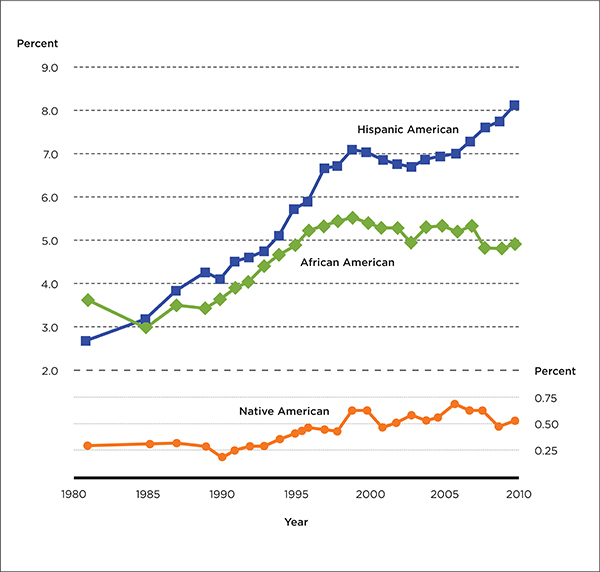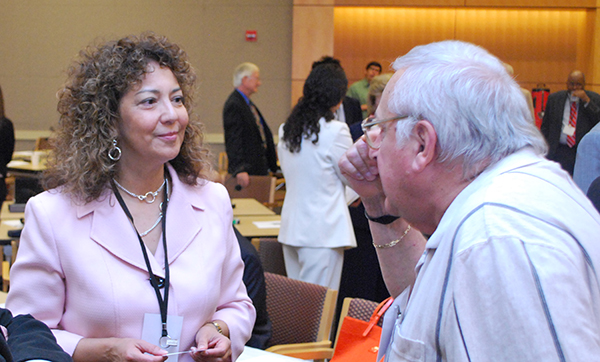SECTION II — FRAMING THE ISSUE: A LONG, SLOW TREK
The workshop was opened by Bevlee A. Watford, Associate Dean for Academic Affairs in the College of Engineering at Virginia Tech and Vice President, External Affairs for the American Society for Engineering Education. She noted that a review of more than 40 years of studies on increasing ethnic diversity in engineering education (see Analysis of Historical Reports in Section III) reveals many commonalities among the recommendations. Thus, there has been something approaching a consensus for many years on what is needed to achieve ethnic diversity in engineering education. Yet the percentage of underrepresented minorities enrolled nationwide remains well below their percentage in the population.
The workshop focus was primarily on efforts that the university-level engineering education community itself could undertake to improve diversity. (Similarly, although earlier studies were sometimes framed around a broader construct, many of their recommendations were directed at the university level.) Given the earlier studies and the similarity of their recommendations, Watford summarized the sense among many in engineering education: “We know what needs to be done. Why is it not happening?” The sentiment, heard many times from many attendees during the two days, was the underlying rationale for the workshop.
Watford articulated the five aims of the workshop:
- to identify and illuminate impediments to diversity,
- to understand why previous diversity recommendations have not been implemented or, if implemented, why they fell short,
- to share success stories about instances where barriers to diversity have been identified and surmounted,
- to identify the resources that would enable real solutions to implement steps toward progress, and
- to locate supporters and allies who could propel change.
In a welcoming address, C. D. (Dan) Mote, Jr., President of the National Academy of Engineering, noted that, while previous attempts to achieve broad ethnic diversity in engineering education had fallen short, it is important to take the lessons from those efforts and consider ways to move forward. This workshop, he said, offers a chance to rethink the issues and do things differently.
SECTION III — PRE-WORKSHOP PREPARATIONS
To prepare for the workshop, attendees were surveyed in advance and asked to answer eight questions ranging from why past attempts to enhance racial and ethnic diversity in engineering had not succeeded to why there are not more summer programs or research assistantships for students from underrepresented minority populations (see Appendix C). The questions were developed following analysis of a preliminary survey of a smaller number of attendees that helped crystallize the main issues. The survey results helped identify a short list of impediments to diversity for use in organizing the discussions of the workshop.
Analysis of Historical Reports
For 40 years studies and reports by various governmental and academic bodies have been presenting recommendations on enhancing ethnic diversity. Many of these are strikingly similar, yet new workshops are still being organized and relatively little has changed. Progress has stalled or even reversed among African Americans and Native Americans, and has occurred only marginally among Hispanic Americans, as shown in Figure 1.
The tables that follow summarize the main thrusts of the recommendations presented in the 17 reports listed at the end of this section. The tables were prepared by Kellie Green while she was a Christine Mirzayan Science and Technology Policy Fellow at the National Academies. Table 1 groups the recommendations by theme, stakeholder, and level of intervention (i.e., at which point in the educational spectrum it made sense to lend a helping hand).

Figure 1. Minorities as a percentage of US baccalaureate engineering graduates
Notes: Data tabulated by the National Science Foundation from the Department of Education and the Engineering Workforce Commission. Different axis scaling used for Native American category to enhance visibility.
Sources: Data for 1981-1989: Women, Minorities, and Persons with Disabilities in Science and Engineering (1994), Appendix table 5-25. Available at www.nsf.gov/statistics/wmpdse94/chap5/appntab/appn525a.xls.
Data for 1990-2010: Women, Minorities, and Persons with Disabilities in Science and Engineering (2013), Table 5-13.Avail-able at www.nsf.gov/statistics/wmpd/2013/tables/tab5-13.xls.
Table 1. Historical Recommendations to Assist in the Recruitment, Retention, and Employment of Underrepresented Minorities in Engineering
| Education Stakeholder | Precollege | College | Postcollege/Graduate or Professional School |
| Student |
|
|
|
| Educational Institution |
|
|
|
| Education Stakeholder | Precollege | College | Postcollege/Graduate or Professional School |
| Government |
|
|
|
| Private Sector |
|
|
|
For the purposes of discussion, the historical recommendations shown in Table 2 were summarized as six general strategic themes for achieving diversity. These themes were used to charge the breakout groups for their discussions on Day One of the workshop.
A. Inculcate and reinforce students’ academic and professional knowledge
- Take courses in science and mathematics
- Tutor and mentor other students
- Generate plans, ideas, goals, etc. for academic support programs
- Evaluate and document their experience
- Take part in summer enrichment programs
- Take part in nonsummer enrichment programs
- Perform public service
- Take part in Upward Bound, Talent Search, and other organizations
- Take part in summer training programs
- Participate in summer research opportunities
- Participate in military awareness programs
- Go to conferences
B. Enhance pedagogy for current and future teachers and faculty
- Develop and maintain teacher preparation courses
- Prepare teachers with science and mathematics training
- Provide teachers with bilingual courses
- Provide minority students with opportunities for self-paced instruction
- Provide teachers and instructors with reduced course loads
- Give teachers and instructors leave time for professional development
- Provide summer workshops for teachers
- Develop and maintain outreach programs for teachers (establish partnerships between precollege teachers and university science and engineering faculty)
- Participate in teacher recruitment
C. Strengthen organizational receptivity to ethnic diversity
- Encourage cross-institutional cooperation to develop programs targeted to minorities
- Help foster individual institution efforts to support minorities
- Develop faculty-/staff-led support activities (e.g., mentoring by faculty and tutoring by students)
- Create research opportunities for undergraduates
- Open cultural centers
- Maintain and develop professional organizations
- Encourage curriculum development
- Encourage collaboration with government and industry
- Encourage the development of minority engineering orientation programs
- Maintain centers for career opportunities
D. Enhance economic enablement of students and student support organizations
- Fund scholarships, grants, fellowships, work study
- Fund support activities (e.g., mentoring, tutoring, professional organizations)
- Develop organized ways to fund programs and evaluate them
E. Enhance stakeholder communication and action
- Communicate engineering and science to the public
- Create a work environment that is inclusive through the creation of policies that are sensitive to minority needs
- Create jobs for minorities
- Publicize positive stories of minority accomplishments
F. Increase educational research and policy development
- Perform self-assessments of programs developed for minorities
- Maintain a database of demographic trends
- Evaluate programs that are targeted to minorities
To illustrate the history of these recurring recommendations for increasing diversity, Table 2 shows a matrix of these six recommendation categories and the decades and reports in which they were presented.
Table 2. Summary of Historical Recommendations by Document and Decade
| Recommendation Categories | 1970s | 1980s | 1990s | 2000s | 2010s |
| A. Inculcating and Reinforcing Students’ Academic and Professional Knowledge | [1], [2], [3] | [4], [5], [6], [7], [8] | [9], [10] | ||
| B. Pedagogical Improvements (targeted to current and future teachers and students) | [1], [2], [3] | [4], [5], [7], [8] | [9], [10] | [11], [12], [13] | [14] |
| C. Organizational Receptivity | [1], [2], [3] | [4], [6], [7], [8] | [9], [10], [15] | [12], [13], [16] | [14] |
| D. Economic Enablement | [3] | [7], [8], [17] | [9] | [12], [13], [16] | [14] |
| E. Public and Community Education and Institutional Involvement | [4], [8] | [11], [13] | |||
| F. More Educational Research and Policy Development | [1], [2], [3] | [4], [8] | [9], [15] | [16] |
Note: Numbers in brackets refer to reports listed under References.

1. Massachusetts Institute of Technology and National Research Council. 1977. Proceedings of the Workshop on Retention of Minority Undergraduate Students in Engineering (Cambridge, Massachusetts, October 30-November 2, 1977). Cambridge, MA: Office of Minority Education, Massachusetts Institute of Technology.
Recommendations A-C, F
2. National Research Council. 1977. Retention of Minority Students in Engineering: A Report of the Retention Task Force. Committee on Minorities in Engineering. Washington: National Academy of Sciences.
Recommendations A-C, F
3. Planning Commission for Expanding Minority Opportunities in Engineering. 1974. Minorities in Engineering: A Blueprint for Action. Summary and Principal Recommendations. New York: Alfred P. Sloan Foundation.
Recommendations A-D, F
4. National Research Council. 1987. Minorities: Their Underrepresentation and Career Differentials in Science and Engineering. Proceedings of a Workshop. Dix, L.S., ed. Washington: National Academy Press.
Recommendations A-C, E, F
5. National Research Council. 1985. Engineering Graduate Education and Research. Washington: National Academy Press.
Recommendations A, B
6. National Research Council. 1986. Engineering Undergraduate Education. Washington: National Academy Press.
Recommendations A, C
7. National Science Board. 1986. Undergraduate Science, Mathematics and Engineering Education. Washington: National Science Foundation.
Recommendations A-D
8. Task Force on Women, Minorities, and the Handicapped in Science and Technology. 1989. Changing America: The New Face of Science and Engineering. Final Report. Washington.
Recommendations A-F
9. National Research Council. 1993. Major Issues in Engineering Education: A Working Paper of the Board on Engineering Education. Commission on Engineering and Technical Systems Office of Scientific and Technical Personnel. Washington: National Academy Press.
Recommendations A-D, F
10. National Research Council. 1996. National Scholars Program - Summary: Excellence with Diversity for the Future. Committee on the Feasibility of a National Scholars Program. Washington: National Academy Press.
Recommendations A-C
11. National Academy of Engineering and National Research Council. 2009. Engineering in K-12 Education: Understanding the Status and Improving the Prospects. Katehi, L., Pearson, G., and Feder, M.A., eds. Washington: National Academies Press.
Recommendations B, E
12. Landis, R.B. 2005 (reprinted from 1991). Retention by Design: Achieving Excellence in Minority Engineering Education. White Plains, NY: National Action Council for Minorities in Engineering.
Recommendations B-D
13. Congressional Commission on the Advancement of Women and Minorities in Science, Engineering and Technology: Development Opportunities in Science and Engineering. 2000. Land of Plenty: Diversity as America’s Competitive Edge in Science, Engineering and Technology. Arlington, VA: National Science Foundation.
Recommendations B-E
14. National Academy of Sciences, National Academy of Engineering, and Institute of Medicine. 2011. Expanding Underrepresented Minority Participation: America’s Science and Technology Talent at the Crossroads. Washington: National Academies Press.
Recommendations B-D
15. National Research Council. 1996. From Analysis to Action: Undergraduate Education in Science, Mathematics, Engineering, and Technology. Center for Science, Mathematics, and Engineering Education. Washington: National Academy Press.
Recommendations C, F
16. Committee on Equal Opportunities in Science and Engineering. 2004. Broadening Participation in America’s Science and Engineering Workforce: The 1994-2003 Decennial and 2004 Biennial Reports to Congress. Arlington, VA: National Science Foundation.
Recommendations C, D, F
17. National Science Board. 2003. The Science and Engineering Workforce: Realizing America’s Potential. Arlington, VA: National Science Foundation.
Recommendation D







